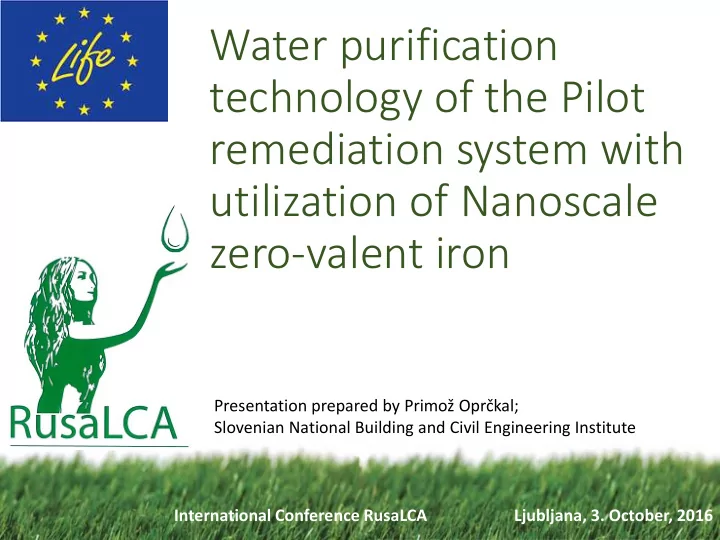

Water purification technology of the Pilot remediation system with utilization of Nanoscale zero-valent iron Presentation prepared by Primož Oprčkal; Slovenian National Building and Civil Engineering Institute International Conference RusaLCA Ljubljana, 3. October, 2016
Responsible Co-Authors and Inventors National • Majda Ivanušič Laboratory for • Gregor Čampa • Ana Mladenovič health, • Alenka Mauko Pranjič environment and Slovenian food • Adrijana Sever Škapin National Building • Peter Nadrah and Civil • Primož Oprčkal Engineering • Alenka Kotar – HID-EKO, Institute PROJEKTIRANJE, INŽENIRING IN SVETOVANJE, ALENKA KOTAR, AmE • Peter Blažek – NOM BIRO, projektiranje in svetovanje , LLC ESPLANADA • Radmila Milačič • Mateja Ličina • Janez Ščančar • Janja Vidmar Jozef Stefan Institute • Zvonko Cotič • Mitja Čotar • Anka Ilc Structum • Rupert Gole • Janko Zakrajšek • Iztok Kovačič Municipality of Šentrupert • Mirko Šprinzer PKG Mirko Šprinzer
Purpose of the remediation technology • Adaptation to climate changes and water scarcity. • Safeguarding of natural sources of drinking water. • Recycling of wastewater. • Upscaling of advanced nanoremediation technology to a higher TRL (from 3 – 4 to 5 – 6). • Fully functional pilot remediation system with utilization nanoscale zero-valent iron for real life application.
The Pilot remediation system • Constructed in March 2015 • Capacity of 100 Population Equivalents • Remediation capacity is approximately 900 m 3 per year
The Pilot remediation system • Discrete and robust design; most of the structures is below ground • Reaction tanks and are made from reinforced polyester • Corrosion resistant pumps and pipe system • Concrete underground tank for on site temporary deposition of waste iron sediment • System is electronically controlled and partly autonomous • Software that enables adjustment of basic parameters • Manual or semi-automatic functioning • Simple management
The Pilot remediation system - Construction
The development • Multistage batch remediation procedure (Nanoremediation in combination with conventional techniques) • Development through laboratory simulations and experiments (more than 150 simulations of nanoremediation) • On a laboratory scale the quality of drinking water was achieved.
The development Parameter Outflow from SBWTP Nanoremediation After remediation Limit values for drinking water Escherichia coli (MPN/100 mL) 24,000 2,400 0 0 Intestinal Enterococci (MPN/100 mL) 3,400 350 0 0 Clostridium perfringens (CFU/100 mL) 380 15 3 0 Coliform bacteria (MPN/100 mL) 73,000 10,000 0 0 + (mg/L) NH 4 10.9 ± 0.5 10.5 ± 0.5 0.45 ± 0.03 0.50 - (mg/L) NO 3 25.6 ± 0.3 28.5 ± 1.4 30 ± 1 50 - (mg/L) NO 2 1.32 ± 0.07 0.43 ± 0.07 0.5 0.534 ± 0.027 2 (mg/L) SO 4 28 ± 1 41 ± 2 56 ± 3 250 Cl - (mg/L) 41 ± 2 41 ± 2 27 ± 1 250 Sb (µg/L) 0.082 ± 0.004 1.03 ± 0.052 1.24 ± 0.07 5.0 1.02 ± 0.052 3.37 ± 0.17 As (µg/L) 0.294 ± 0.015 10 Cu (mg/L) 0.0261 ± 0.0013 0.0036 ± 0.0002 2 0.0030 ± 0.0002 0.059 ± 0.003 0.060 ± 0.003 B (mg/L) 0.063 ± 0.003 1 0.883 ± 0.044 0.052 ± 0.003 0.016 ± 0.001 Cd (µg/L) 5.0 Cr (µg/L) 0.559 ± 0.028 0.161 ± 0.008 50 0.543 ± 0.027 5.07 ± 0.25 1.29 ± 0.06 Ni (µg/L) 1.48 ± 0.07 20 Se (µg/L) 0.152 ± 0.008 0.080 ± 0.004 0.081 ± 0.004 10 Pb (µg/L) 13.1 ± 0.66 0.714 ± 0.036 0.289 ± 0.014 10 Hg (µg/L) <0.001 0.074 ± 0.004 0.032 ± 0.002 1.0 15.6 ± 0.8 4.96 ± 0.25 Al (µg/L) 35.0 ± 1.7 200 Mn (µg/L) 15.0 ± 0.8 3.05 ± 0.15 50 29.5 ± 1.5 Na (mg/L) 52.6 ± 2.6 67.2 ± 3.4 200 26.3 ± 1.3 927 ± 46 175 ± 9 Fe (µg/L) 124 ± 6 200
Small wastewater treatment plant
1. Small wastewater treatment plant • Sequence Batch Reactor (SBR), • Limit values COD=150 and Rotating Biological Contractor BOD 5 =30 mg/ O 2 L (RBC), Moving Bed Biofilm • Unexploted source of water in Reactor (MBBR) front of our doorstep. • Suitable for areas with low population density COD BOD
1. Small wastewater treatment plant Why do we simply not use the effluent water from SBWTP? • Occasional exceeding concentrations of metals • Traces of pharmaceuticals and POPs • Presence of pathogenic microorganisms • Turbidity and occasionally suspended matter E. Coli Intestinal Enterococci Clostridium perfringens Coliform bacteria
2. Nanoremediation Innovative technology of Nanoscale zero-valent iron (nZVI): • „green chemical“ • Remarkable remediation abilities: o Degradation of organic pollutants o Removal of metals o Disinfection • Spent particles after remediation: o Are agglomerated in to micrometre size particles that separate from water by settling or filtration. o Are transformed in to nonreactive iron (hydr)oxides. o In remediated water are not present. o Waste iron sediment has high potential for recycling.
Nanoremediation Additional disinfection and removal of contaminants is, after nanoremediation, done with other conventional techniques for water purification.
Remediated water • Suitable for secondary purposes of local inhabitants. • Available at the pilot remediation system in a storage tank - 40 m 3 . • Content of metals is below limit values for drinking water • 99.9 % disinfection efficiency of the remediation system. • Organic pollutants were not detected • Water is clear and odourless
Zero-waste management Waste organic sludge from the SBWTP: • Collected sludge must be first processed at the urban wastewater treatment plant. • Processed sludge is than used for production of geotechnical composite.
Zero-waste management Spent iron particles: • Sludge or suspension of iron (hydr)oxides • Collected and temporarily stored on site in a concrete underground tank • Use in concrete
QUESTIONS ?
Recommend
More recommend